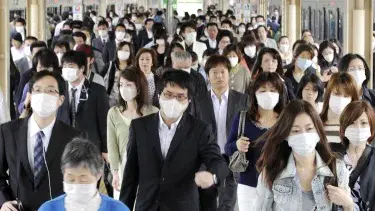By APD writer Alice
In Asia, wearing a mask is the responsibility of all people to protect themselves and prevent the spread of infectious diseases to others, but to Europeans, it is a symbol of the disease.
In Asian countries, memories of the Severe Acute Respiratory Syndrome (SARS) epidemic 17 years ago are still haunting and wearing masks has become a habit. Many consider it a responsibility to minimize transmission of COVID-19, a disease that has caused more than 220,000 infections and killed nearly 9,000 people in more than 170 countries around the world by March 20 morning.
Some businesses do not allow customers to enter the stores without wearing a mask. Authorities in major cities like Beijing and Shanghai have required citizens to wear masks in public places.
But in many European countries and the United States, face masks can cause racial discrimination and stigma against those of Asian descent. A Chinese student from the Britain’s University of Sheffield was verbally and physically harassed in January for wearing a mask, and a Chinese woman was assaulted and called “diseased” in New York in February for doing the same.
In Germany, almost all people do not wear masks despite the number of COVID-19 infections and related deaths is on the rise. In addition to not wearing masks, people in Germany also have a negative view of Asians, especially those wearing masks.
"People only wear masks when they are sick, so Vietnamese people who wear masks often receive scrutiny and discrimination," said Nguyen Gia Khanh, a Vietnamese student who has been in Germany for more than a year.
When wearing a mask on the road and meeting with young groups, Khanh will try to keep her distance from them. "Once they ran up to me and shouted 'The coronavirus here' and laughed," Khanh shared.
Maria Sin Shun-ying from the University of Hong Kong wrote in 2014 about the relationship between SARS and masks “to a degree that the mask itself served to delineate the disease’s identity” and it is construed in the Western media as a distinctly ‘Asian’ phenomenon.
According to Harris Ali, a sociologist at York University (Canada), in North America, mask-wearing retained its association with Asian people.
“It’s still seen as kind of outside the norm, and therefore not accepted. So the mask in that sense does become a stigmatising symbol, especially if that’s not the norm,” he said.
The World Health Organisation has said healthy people generally do not need to wear face masks. This further consolidate the view of the Western countries on mask wearing.
US surgeon general Jerome Adams, the top federal government spokesperson on public health, urged Americans on Twitter to stop buying masks, as it could limit stocks for health care workers.
“Seriously people – STOP BUYING MASKS!” he wrote. “They are not effective in preventing the general public from catching coronavirus, but if health care providers can’t get them to care for sick patients, it puts them and our communities at risk!”
Health experts have mixed views on the effectiveness of face masks in preveing the spread of the coronavirus, believed to be transmitted through respiratory droplets that can come from coughing or sneezing. Some argue that handwashing is more important , while others say masks can help stop transmission from people who are asymptomatic.
Face masks are common in East Asia, not only to prevent virus spread but also to block air pollution and even fend off cold weather. Japan, for example, has a long history of mask-wearing dating back to the Spanish influenza outbreak of 1918-19. The practice has since become socially embedded as a self-protection ritual and part of people’s collective responsibility.
In Japan, wearing face masks has become a very common practice against the flu, and in the seventies and eighties people started using them for hay fever, said Mitsutoshi Horii, a professor at Shumei University who has researched mask-wearing in Japan. More recently, people started wearing masks more due to a public scare about polluted air from China.
People in Japan also wear masks to cover facial blemishes, keep warm in winter and help with shyness, he said, adding Japanese just naturally wear masks to feel safer. But in the West, because of strong resistance and belief in the importance of showing the face, people tend to have negative ideas about masks.
Sociologist Harris Ali added that during the SARS outbreak, masks in Hong Kong became a symbol of solidarity against the disease. In a Chinese context, especially Hong Kong context, the stigmatised aspect is lost, and in fact masks may have the opposite value, he said.
“In a more collectivist culture, the wearing of a mask takes on more significance than it does in the Western world,” Ali stressed.
“Dramatic photos of masked crowds walking the streets of Asian cities, such as Hong Kong, were disseminated globally,” said Maria Sin Shun-ying.
Since SARS, face masks as protection against pollution have been increasingly popular in Asia by fashion designers and by celebrities including members of Korean boy band sensation BTS.
And now, masks have become more and more familiar to Westerners. Many Western stars including Bella Hadid, Kate Hudson and Gwyneth Paltrow have posted masked selfies on social media during the coronavirus outbreak. Croatian designer Zoran Aragovic launched a speciality “cheerful” face mask collection earlier this month.
On streets of Asian countries, including Vietnam, in recent days, it is easy to see foreigners from Europe and America wearing face masks following the local government’s regulations.
Fears of an epidemic could temporarily reduce culturally informed resistance to masks but in a wider context it would be “very difficult to change this deep aspect of Western culture”, Mitsutoshi Horii said.
(ASIA PACIFIC DAILY)
 简体中文
简体中文

